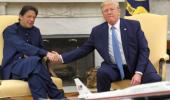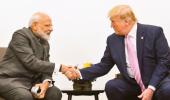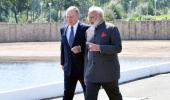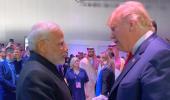‘When your economy is growing at 8 per cent or above, it is a case of what you might call saat khoon maaf (you can get away with seven murders). At 7 per cent, it becomes paanch (5) khoon maaf. But once your growth is 5 per cent, you are in a dodgy zone,’ says Shekhar Gupta.
Illustration: Dominic Xavier/Rediff.com

India is facing a rising, new strategic threat. It isn’t another brigade the Pakistanis moved to the LoC, or another overly dramatised missile test. It isn’t even some new incursion by the Chinese.
Three things this new threat isn’t.
It isn’t military, it doesn’t come from our traditional adversaries, and it doesn’t lurk from across our borders.
And here are the three things this new threat is. It is economic, it comes from within, and it threatens to ruin our greatest asset of the past two decades: Global goodwill, the rising “good guy” image in the post-9/11 world, only partly because of our stability and democracy, but predominantly because of our rising economic strength.
For simplicity of understanding, see it this way: When your economy is growing at 8 per cent or above, it is a case of what you might call saat khoon maaf (you can get away with seven murders). At 7 per cent, it becomes paanch (5) khoon maaf. But once your growth is 5 per cent, you are in a dodgy zone.
This is when a rising global power becomes just another flailing Third World economy with a per capita income in that lowly $2,000 ballpark (Sri Lanka is twice this).
For about 25 years since economic reforms were launched in the summer of 1991, India had risen to be the favourite of the world, in the West, the East and in the Middle-East.
India’s unique socio-political attributes, its ability to flourish with its diversity when large parts of the world were struggling with it, democracy, and strategic restraint had enhanced its global stature. It reflected in the support India received during Kargil, Op Parakram after the Parliament attack, and 26/11.
The bigger strength was, however, economic.
India was not only the second-fastest growing major economy even in a world growing at express speed, it was grabbing global attention for its rising tech prowess, innovation, friendliness to foreign capital, stable markets, and tax regime.
India also drew global admiration for the way it shepherded itself out of the 2008 global downturn.
Over these years, India rose as a moderate, predictable, and stable continent-sized growth island in a turbulent world, a magnet for global portfolio and direct investment. It gave big powers -- including China -- and their corporations a stake in India’s stability and security.
This is how a red-hot economy became India’s greatest strategic strength in a period when its military spending lagged and modernisation lost pace and direction.
Growing GDP was now more powerful than all the megatonnage of nuclear weapons.
If a big power invested in your sovereign or corporate bonds, the last thing it wanted was to be party to any action or policy that destabilised you.
Even for the Chinese, the trade surplus rising up to $60 billion depended on a booming Indian consumer economy.
Surely, they sell India a lot of machinery, power-generation equipment, and engineered goods.
But which other economy had the size and hunger to swallow tens of billions of dollars’ worth of its low-quality, almost no-tech junk they produce: Toys, slippers, furniture, parasols, gaudy veneers, agarbattis, plastic bangles, trinkets and much other junk that fills the shop shelves in middle and rural India.
This Chinese dependence on India’s capacity to import in volumes that no other economy could vicariously became a strategic asset for India as well.
Check out, therefore, China’s responses when war-like crises rose between India and Pakistan: Kargil (1999), the Parliament attack (2001-02), and 26/11 (2008).
Each time, these were qualitatively better and more helpful than lately.
Even the 2009 tensions over the Dalai Lama’s visit to Tawang, when Manmohan Singh’s considerably less muscular government bravely stared down China, were calmed down uneventfully.
For much of the first term of the Modi government, the growth momentum was not only maintained, but accelerated after the 2012-14 stall.
India benefited from it, as did Narendra Modi. His image and stature rose greatly in the community of global leaders.
But he broke his momentum himself with demonetisation. India’s economic growth has been downhill since.
The big decline has come in the last four quarters and at this point, nobody is expecting any recovery soon.
This is now diminishing and damaging India’s global stature. And it reflects in many of the responses over the abrogation of Article 370.
It was indeed a turning point -- and provocation -- much greater than any from India since the launch of the 1971 war.
But the first indication of this strategic downside of our declining growth had come even before this when US President Donald Trump talked casually of mediating between India and Pakistan, in Pakistan Prime Minister Imran Khan’s presence.
Trump will be Trump, but it is unlikely that he would have taken such a chance if India’s economy was vibrant as earlier, his companies were investing and making profits rather than coming to him, complaining about Indian tariffs, and loss of policy predictability.
Walmart, Amazon, medical and drug manufacturers, were all crying to him as India made sudden changes to its set policies, including taxation.
Today, a broken Tory government in Britain is talking down to India almost admonishingly on Kashmir, besides acting in a hostile manner at the UN Security Council.
Even Tony Blair’s Labour had shown greater respect for India in the booming past.
Between 2002 and 2013 there were six prime ministerial visits to India. You did, of course, expect goodwill for India to cut across party lines when an Indian conglomerate (Tata) acquired Jaguar Land Rover (JLR) and Corus for $14.3 billion and became Britain’s largest private-sector employer.
All analysis is ultimately hypothetical, but you can’t just toss it because you don’t like it. Not when it is based on facts.
When Trump sat with Imran at that press conference, in his uncluttered mind, India wasn’t a strategic ally, but a pesky trade warrior and irritant.
On the pure strategic side, it wasn’t willing to annoy China and its interests in Afghanistan conflicted with Trump’s.
Some repair work was done at Biarritz last month and a new trade deal can calm things down there. We will know this month in the UN General Assembly (UNGA) week.
The meeting to watch, more than Modi-Trump, will be between Commerce Minister Piyush Goyal and US Trade Representative Robert Lighthizer. And if it does restore some calm, as it probably will, our point about economy and trade being the new megatonnage of strategic clout would be made.
While the situation in Kashmir looks bad today, it isn’t the worst ever. We tend to forget even our recent past, especially if it was pre-Google.
In 1991-94, popular anger, State response, repression and violence in the Valley were the worst yet. Torture centres flourished, foreign journalists were barred, encounter killings were common. Punjab was on fire, too, with multiple killings daily.
This also coincided with an angry international response and India was friendless.
The Soviet Union, our only ally, had just disappeared. America, driven by human rights and non-proliferation groups close to the Bill Clinton administration, were targeting India relentlessly.
There wasn’t one public event in Washington where a stellar team of Indian diplomats didn’t have to field attacks over allegations of mass murder and rape as a military tactic in Kashmir.
P V Narasimha Rao was dealing with all this quite mercilessly at home despite being friendless in the world.
The BJP will give him his well-deserved Bharat Ratna in the course of time, and please do remind me then that I had said so.
But maybe not for what remains his biggest achievement: Showing us how economics is the biggest post-Cold War strategic asset.
He started economic reform in the summer of 1991, the markets, GDP and trade boomed, and India’s friends appeared in unlikely global capitals.
Note the contrast between the first Clinton administration (which included assistant secretary of state Robin Raphel, who questioned the instrument of accession) and the second term when Clinton declared that lines on the subcontinent’s map could no longer be redrawn with blood.
If a fast-growing economy was a decisive strategic asset even in the early 1990s, a slowing one is bound to be a liability in 2019.
By special arrangement with ThePrint












 © 2025
© 2025